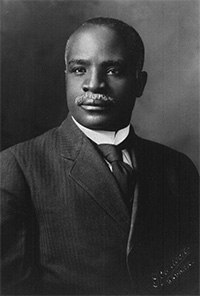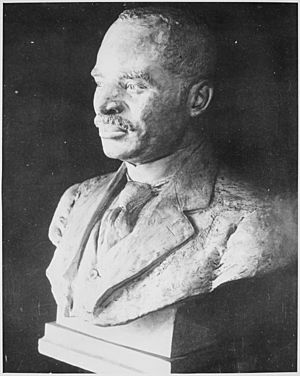Kelly Miller (scientist) facts for kids
Quick facts for kids
Kelly Miller
|
|
|---|---|
 |
|
| Born | July 18, 1863 |
| Died | December 29, 1939 (aged 76) |
| Resting place | Lincoln Memorial Cemetery |
| Occupation | mathematician, sociologist, essayist, newspaper columnist and author |
Kelly Miller (July 18, 1863 – December 29, 1939) was an important American thinker. He was a mathematician, a sociologist (someone who studies human society), an essayist (a writer of short articles), and a newspaper writer. For nearly 50 years, he was a key leader in the intellectual life of Black America. People sometimes called him "the Bard of the Potomac."
Contents
Kelly Miller's Early Life and School
Kelly Miller was born in Winnsboro, South Carolina. He was the sixth of three children. His mother had been a slave, and his father was a free Black man. Kelly went to local schools in Winnsboro.
From 1878 to 1880, Kelly attended the Fairfield Institute. He did so well that he earned a scholarship to Howard University. This is a historically black college. Kelly finished a three-year program in Latin, Greek, and math in just two years. He quickly moved through different subjects. He studied at Howard's College Department from 1882 to 1886.
In 1886, Kelly had a chance to study advanced math. He worked with Captain Edgar Frisby, an English mathematician. Frisby's assistant, Simon Newcomb, noticed Kelly's talent. He suggested Kelly study at Johns Hopkins University. Kelly spent two years there (1887-1889). He became the first African-American student to attend Johns Hopkins. He studied math, physics, and astronomy. He was also the first African American to study graduate-level math in the United States.
Kelly Miller was a member of the Alpha Phi Alpha fraternity.
His Career and Work

Kelly Miller could not afford to stay at Johns Hopkins University. So, from 1889 to 1890, he taught math at M Street High School in Washington, D.C. In 1890, he became a math professor at Howard University. In 1895, he started teaching sociology there. He taught sociology until 1934. Kelly also graduated from Howard University School of Law in 1903. In 1907, he became the dean of the College of Arts and Sciences.
His time as dean lasted 12 years. During this time, the college changed a lot. The old way of teaching was updated. New courses in science and social studies were added. Kelly strongly supported Howard University. He worked hard to get students to attend the school. In 1914, he planned a Negro-American Museum and Library. He convinced Jesse E. Moorland to give his large library about Black people to Howard. This collection became the start of the museum and library.
Kelly Miller was part of a meeting on March 5, 1897. This meeting honored Frederick Douglass. It also started the American Negro Academy. This group was led by Alexander Crummell. Kelly was one of its most active members until 1928. The Academy worked to correct racist ideas. It also promoted equal rights for Black people. They published early histories and studies of African American life.
Miller became well-known nationally for his work with W. E. B. Du Bois. He was a leader during a time of disagreement. Some, like Booker T. Washington, believed in "accommodation." Others, like Du Bois, believed in "radicalism" for civil rights. Kelly Miller tried to find a middle path. He believed in a complete education system. This system would offer both job training and academic learning. He felt this would help Black citizens develop fully.
In February 1924, Kelly Miller was chosen to lead the Negro Sanhedrin. This was a civil rights meeting in Chicago. It brought together leaders from 61 African-American groups. They wanted to work together and create a plan for social and political change.
He believed that Black people should support free market ideas. He thought this was better than relying on government or unions. He said that business owners care about making and selling goods. The race of the worker matters little to them. He felt that businesses support an "open shop." This means everyone has the right to work based on their skills. He believed that Black people and business owners shared this goal.
He also spoke out against unfair policing in 1935. He said that police violence hurt trust in the community. He noted that often, the police were the only part of the law Black people met. This made them distrust all public officials.
His Written Works
Kelly Miller wrote many articles and essays. These were printed in major newspapers, magazines, and books. One of his books was Out of the House of Bondage. He also helped W. E. B. Du Bois edit The Crisis. This was the official magazine of the National Association for the Advancement of Colored People (NAACP). Miller first published his articles without his name in the Boston Transcript. He wrote about both radical and conservative groups. He also shared his ideas in other journals.
His anonymous articles later became part of his book Race Adjustment (1908). In this book, Miller said that African Americans had the right to protest. They could protest against the unfairness that came with white supremacy in the South. Miller supported racial harmony, saving money, and building strong communities.
In 1917, Miller wrote an open letter to President Woodrow Wilson. It was published in the Baltimore Afro-American. He spoke against lynching, which he called "national." He said the government's failure to stop it was "the disgrace of democracy." He also said it was unfair when Black people were hurt and sought help from the government but were denied. He felt they were given excuses instead of protection.
This letter was shared in US army libraries for about a year. Then, military censorship ordered it removed. They said it might make soldiers less effective fighters. In 1919, Miller published Kelly Miller's History of the World War for Human Rights. This book included many pictures of the war. It also showed the role of Black soldiers and sailors.
Later Life and What He Left Behind
After the First World War, Kelly Miller faced some challenges. In 1919, his role at Howard changed. He continued to write articles and weekly columns for Black newspapers. His ideas were published in over 100 newspapers.
Kelly Miller passed away in 1939 on Howard's campus. He was survived by his wife, Annie May Butler. He also left behind four of his five children: Kelly the III, May, Irene, and Paul. His son, Isaac Newton, had passed away before him.
A housing complex with 160 units was built in LeDroit Park in 1941. It was named after him. Kelly Miller Middle School in Washington, D.C., is also named in his honor.

